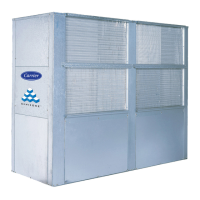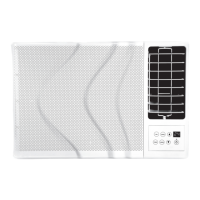2
GENERAL
Omnizone™ indoor packaged units are designed to provide the
flexibility required in replacement, renovation, and new construc-
tion. Units are available in 6 sizes from 5 tons to 20 tons. Belt-
drive condensers provide adequate static to overcome normal
ducting and louver static losses. This allows units to be positioned
against an existing window or wall louver, or ducted to the outside
as required.
Convenient rear connections allow easy access for outside air con-
nections. Unit supply air discharge is vertical as standard, and hor-
izontal as optional for sizes 12 and 24. These vertical packaged
units are fully piped and wired. Units are complete with a belt
drive evaporator section and built-in ducted air-cooled condenser.
Most units are designed to fit through most standard doors. See
Fig. 1-9 for unit dimensions and refer to Table 1 for unit operating
weights.
INSTALLATION
Omnizone 50XCA units are intended for indoor installation only.
Determine building alterations required to run piping, wiring and
ductwork. Follow dimensional drawings for ductwork, piping lo-
cations, electrical wiring and overall unit dimensions. Read all in-
stallation instructions before installing the unit.
Step 1 — Complete Pre-Installation Checks
Examine unit for damage that might have incurred during ship-
ment. File claim immediately with transit company if damage is
found. Check the shipment for completeness. Verify that the
nameplate electrical requirements match the available power
supply.
DO NOT place the unit in a horizontal position. Do not allow re-
frigerant lines to come into contact with wiring or sharp objects or
edges. Do not lift or move unit by putting pressure on refrigerant
lines, blowers, compressors, motors, or coils.
DANGER
DO NOT USE TORCH to remove any component. System
contains oil and refrigerant under pressure.
To remove a component, wear protective gloves and goggles
and proceed as follows:
a. Shut off electrical power to unit.
b. Recover refrigerant to relieve all pressure from system
using both high-pressure and low pressure ports.
c. Traces of vapor should be displaced with nitrogen and
the work area should be well ventilated. Refrigerant in
contact with an open flame produces toxic gases.
d. Cut component connection tubing with tubing cutter and
remove component from unit. Use a pan to catch any oil
that may come out of the lines and as a gage for how
much oil to add to the system.
e. Carefully un-sweat remaining tubing stubs when neces-
sary. Oil can ignite when exposed to torch flame.
Failure to follow these procedures may result in personal inju-
ry or death.
CAUTION
DO NOT re-use compressor oil or any oil that has been ex-
posed to the atmosphere. Dispose of oil per local codes and
regulations. DO NOT leave refrigerant system open to air any
longer than the actual time required to service the equipment.
Seal circuits being serviced and charge with dry nitrogen to
prevent oil contamination when timely repairs cannot be com-
pleted. Failure to follow these procedures may result in dam-
age to equipment.

